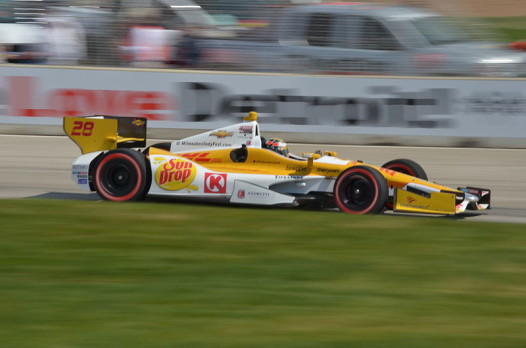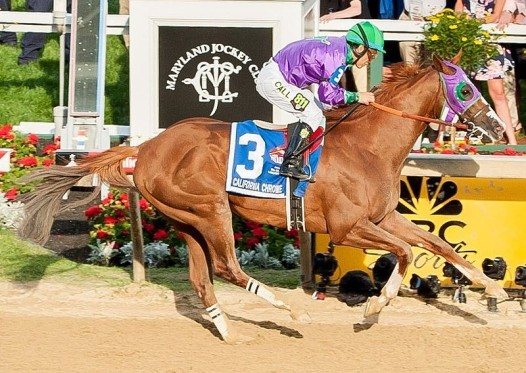Horse racing enthusiasts are looking forward to Saturday’s Belmont Stakes, when California Chrome has the potential to become the 12th Triple Crown winner in racing history. Car racing enthusiasts are still celebrating last week’s Indianapolis 500, when Ryan Hunter-Reay won a photo finish with a series of daredevil moves.
Hear Renee Peck on WWNO
In New Orleans, we have both kinds of racing. Or we will soon. Horse racing at the New Orleans Fair Grounds has been around since the track opened in 1852. And in 2015, the NOLA Motorsports Park in Avondale will host its first ever Indycar event. Race car driver Graham Rahal (his team is partly owned by David Letterman, but that’s another story) dropped into town recently to announce the inaugural Grand Prix of Louisiana. They’re thinking either March or June next year for the three-day IndyCar series event.

Ryan Hunter-Reay’s winning wheels. (Photo: Nic Redhead)
Anyway, now that New Orleans has both horse and car racing, we decided to see what the two sports have in common. All of those Fair Grounds enthusiasts may want to trek across the river next spring to catch speed on four wheels instead of four legs. And vice versa.
First, the terrain. The New Orleans Fair Grounds has a simple oval turf track that is seven furlongs, or just under a mile, in length. Furlong comes from an Old English word that referred to the length of a furrow ploughed across one acre of an open field. (Who else would tell you these things?)
By contrast, the New Orleans Motorsports track is 2 3/4 miles long. It has 16 turns, as well as a 5,200-foot straightaway that, according to Rahal, has race car drivers drooling.
Horses run once around any particular track. An average race horse runs 39 miles per hour. The record for the Belmont Stakes is two minutes and 24 seconds, set by Secretariat in 1973. I’ll let you do the math on exactly how fast that was.

California Chrome wins the Preakness (Photo: Jay Baker for Maryland GovPics)
Race cars go about five times faster, with top speeds of 235 mph for an IndyCar series event. And cars circle the track not once, but hundreds of times. An Indy driver going 200 miles per hour can cover the length of a football field in less than one second.
Horses, of course, run on grain, hay and grass. Thoroughbreds burn through 35,000 calories and consume 1 to 2 percent of their body weight each day. Hence, I suppose, the phrase “eats like a horse.” Because of their high-grain diet, thoroughbreds can be susceptible to stomach ulcers.
Race cars don’t run on gasoline, but on ethanol, which is also grain-based. If an Indy car engine were installed in a lawn mower, it could cut a half-acre lawn in about 5.6 seconds. That’s a whole lot faster than a horse. Indy car drivers, we assume, are probably susceptible to stomach ulcers, too. But not because of their diet.
Thoroughbreds weigh about 1,000 pounds, without the jockey. IndyCar race cars weigh about 1,500 pounds, without the driver.
Despite their differences, both horse racing and car racing lure fans in similar ways.
They tend toward close finishes – horses by noses and cars by hundredths of a second.
They have big purses. California Chrome took home a $1.2 million check for the Kentucky Derby, Hunter-Reay a $2.49 million one for the Indy 500.
They are steeped in tradition — roses for the Derby winner, a glass of milk for the top finisher at the Indy 500. (Don’t ask.)
They lend themselves to arcane trivia. Car racing fans know that the Indianapolis Speedway was nicknamed “The Brickyard” because the track was once paved with bricks. And any avid horse racing fan knows that California Chrome has been cleared to wear his usual equine nasal strips for Saturday’s race.
Both types of racing also draw their own drinking crowd. Car racing goes hand in hand with beer, while the official drink of the Belmont Stakes is the whiskey-based Belmont Breeze. Add Mint Juleps and Black-eyed Susans (the official drinks of the Kentucky Derby and the Preakness), and even the most casual New Orleans fan will want to attend your viewing party (regardless of the racing type).
Ultimately, though, racing of any kind is about the thrills.
Riding a racehorse, says equine expert Ava Gooding, is like riding a freight train balanced on four ankles that are smaller than that of most people.
And driving a race car? Here’s how Formula One driver Jenson Button describes it: “When you’re driving a 750hp machine at 200mph, the noise and the vibrations are incredible. The G-force when you take big corners is like someone trying to rip your head off. You hit the brakes, and it feels as if the skin is being pulled off your body.”
Who wouldn’t love that? See you next year at the race track. On either bank.
The NOLA Motorsports track holds monthly race driver experiences at which novices can pilot a souped-up Mustang race car around the track. Next one is June 20; for info click here.
Catch the view from California Chrome’s back here:
And from the race car driver’s seat here:
 NOLAbeings Multimedia artist Claire Bangser created NOLAbeings as a portrait-based story project that marries...
NOLAbeings Multimedia artist Claire Bangser created NOLAbeings as a portrait-based story project that marries...  Voodoo in New Orleans: Reviving history: New Orleans fortune telling This article takes a deep dive into the history of Voodoo in New Orleans, its hybridization with Catholicism, and its present-day place in the city's culture. The author visits fortune-tellers in the French Quarter, using their guidance as a tool for introspection rather than a deterministic predictor of the future. Through her experiences in New Orleans, the author feels a mystical connection to both the past and the future.
Voodoo in New Orleans: Reviving history: New Orleans fortune telling This article takes a deep dive into the history of Voodoo in New Orleans, its hybridization with Catholicism, and its present-day place in the city's culture. The author visits fortune-tellers in the French Quarter, using their guidance as a tool for introspection rather than a deterministic predictor of the future. Through her experiences in New Orleans, the author feels a mystical connection to both the past and the future. 